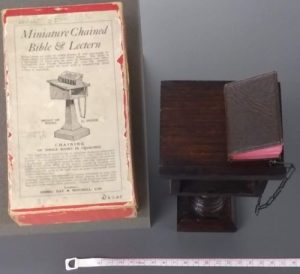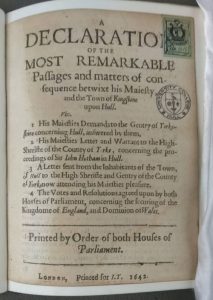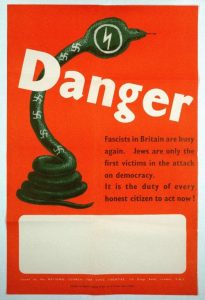Library of the Week: 24th April: We have a very exciting post this week from the University of Hull! Find out more about their incredible Rare Books and Special Collections in this new post by Maggie Sarjantson, Collections Development Manager at the University of Hull – thank you for taking part!
I have the pleasure of overseeing the rich collections in the Brynmor Jones Library (BJL) on campus, and Hull University Archives (HUA) at Hull History Centre (HHC), including our Rare Books and Special Collections. Together, we hold almost 1,000 years of history. Although in separate locations, the collections are interconnected. HUA’s themed research guides help users navigate the collections, and we are planning something similar for the Library.
The highest point on campus, the BJL’s Observatory is a popular destination because of its panoramic views of the city and surrounding area, including landmarks such as the Humber Bridge and Beverley Minster. It is also home to The Cube, the nickname for the Rare Books and Special Collections Room created during the redevelopment in the 2010s.
Visiting The Cube is by appointment, but we organize supervised displays for Open Days, and special events. Regardless of their subject interest, prospective students are interested in the books’ age and provenance. People express surprise that Hull has such treasures, perhaps associating them with older institutions.

We are often asked which is the oldest book; the most important; the largest; the most valuable. We’re happy to answer questions, and talk about value in terms of culture, history and research rather than money. Among the most remarked upon items is the comparatively modern miniature chained Bible and lectern. The lectern is just five and a half inches high, and the book smaller making it almost impossible to read even with the magnifying glass! It contrasts nicely with one of our larger works, The book of the dead: the papyrus of Ani in the British Museum (1895) which barely fits on a table.
The majority of works in the main collection predate 1800. The scope cannot be captured here, and examples are English incunabula, including Subtilissimi doctorus Iohannis Scoti scriptum in quartum librum sententiarum Magistri Petri Longobardi (1473); a first edition of John Stow’s Survey of London (1618); The compleat herbal (1719) by Joseph Pitton de Tournefort, botanist to the French king; a first edition of Samuel Johnson’s A dictionary of the English language (1755); fine printing, e.g. from Doves, Eragny, Kelmscott and Nonesuch Presses.

We all have favourite works and mine are Hooke’s 1665 Micrographia (featured in the Royal Society blog), and pamphlets from the so-called English Civil War. A declaration of the most remarkable passages and matters of consequence betwixt His Maiesty and the towne of Kingstone upon Hull, refers to Sir John Hotham whose self-penned defence is held in HUA. Ultimately, it did not save him from the Tower.
The Cube also holds a number of named collections, notably The Brynmor Jones Collection. Established upon his retirement as Vice-Chancellor (1956-1972) in recognition of his support and funding for the extension of the Library building and collections, this collection’s themes complement the University Art Collection: fine press books produced during the era of fine printing, 1890-1940; and selected landmarks in literature, history, science, politics and philosophy of the same period.

Additionally, we are fortunate to hold important parts of Hull’s heritage, including the libraries of Holy Trinity parish church, now Hull Minister; St. Mary Lowgate and Hull Grammar School.
HUA is part of the University Library, and located at a joint venture with Hull City Archives. The purpose-built History Centre provides high-quality storage and is designed as a seamless public service, allowing users to access material from both repositories on one site. The Centre enables us to partner on outreach activities such as exhibitions, talks and events, and reach wider audiences than either service would alone.
HUA collections include local family and estate records, politics and campaigning, maritime studies, and modern English literature, poetry and drama, plus the University of Hull’s own records. The Archivists run workshops and teaching sessions to introduce students to using archives in their research, and develop online learning and teaching resources.
Again, it is impossible to capture the scope of the collections and you’ll find more information in our guide to Collections at HHC. Highlights include:
- Papers of Philip Larkin, poet and University Librarian, and his extensive photograph collection and many family papers.
- Papers of the Sykes family of Sledmere, including the substantial correspondence of Sir Mark Sykes, architect of the Sykes-Picot Agreement.
- Records of Liberty, the civil liberties campaign group, from its formation in the 1930s up to the 2010s.
- Records of Ellerman’s Wilson Line, based in Hull, this was once the world’s largest privately-owned shipping line.
- Records of the Co-operative Women’s Guild, formed in 1883, which promoted a combination of socialism and feminism.



Social justice is a strong theme in HUA’s collections because of the nature of the materials held, and this is reflected in related holdings within the Library. However, like many organizations we have much to do to address the biases within our services, spaces, collections, and catalogues. Our long-term commitment includes changing policies and practices, working with university, city colleagues, customers and stakeholders to implement change.
An exciting part of this is the Professional Practice Fellowship undertaken by one of our Archivists, Sarah Pymer. Her research, Disrupting archival provenance to bring hidden histories to light, investigates questions around archival theory and the ways in which archival provenance contributes to the obscuring of minoritized histories within archive catalogues.
Of course, nothing gives us more pleasure than seeing how our collections are being used, and I’d like to end by sharing an outcome from recent Historic England internships. This street art on Whitefriargate and Silver Street (a regeneration area) is inspired by The origin and adventures of a Hull eighteen-penny silver token, published in Hull in 1811, and helps to bring our collections into the local community.

Maggie Sarjantson, Collections Development Manager
You can explore the library’s collections on Discover and find further contact details on their Discover information page. Explore HUA’s collections in Archives Hub.

